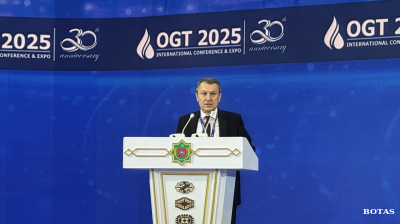Each morning, food distributor Suren Bat-Tur goes to the Bars wholesale food market in Ulaanbaatar to purchase produce for resale. Lately, the mushrooms, coriander, tomatoes and other grocery items he buys have hit eye-watering prices.
“The cost of all my products just goes up and up, some items doubled compared to a year or two ago,” said Bat-Tur, 57. “For ordinary Mongolian buyers, they just cannot afford it anymore, so they buy 100 grams of oil and a few vegetables at a time.”
Mongolia’s consumer price index has averaged 15% over the past eight months amid mounting global headwinds. The coronavirus (COVID-19) lockdowns in Ulaanbaatar and the disappearance of foreign investors due to lockdowns hit the economy two years ago. Now China’s frequent border closures and Russia’s invasion of Ukraine are combining to escalate prices again.
Some of the biggest cost increases are in foods and non-alcoholic drinks, which have surged 22% this year, on top of an 11% rise last year, according to data compiled by the National Statistical Office. Health and medical services are up 18% this year and transportation costs rose 19%.
Consumer buying power took another blow last week when the country’s central bank announced that it had raised interest rates two percentage points to 12%. It’s the fourth time this year the Bank of Mongolia has hiked its policy interest rate, raising it by six percentage points.
“Persistently high inflation severely impacts on the real income of households, and deteriorates purchasing power,” said Sandagdorj Bold, senior economics officer for the Asian Development Bank (ADB) in Ulaanbaatar.
The rate hike will make borrowing more expensive but is designed to curb spending and slow the rising cost of goods. Or so the theory goes for central banks. But the solution is often more complicated and in the case of Mongolia, prices are usually determined by external forces.
“Relying only on monetary policy tightening to address inflation could be destabilising,” said Angana Banerji, the International Monetary Fund’s mission chief in Ulaanbaatar.
Strong fiscal consolidation, or policies that reduce debt, are also needed to support monetary policy efforts to contain inflation, she said.
Getting a handle on inflation would help alleviate stress on Mongolia’s poor and low-income households. Just buying basic foodstuffs has been a challenge for thousands of families, especially during China’s periodic border closures. Russia’s invasion of Ukraine has also pushed up prices due to soaring energy costs.
“We have increasing prices, imports are expensive, we feel it every day when the price of products is increasing,” said Bayanjargal Byambasaikhan, vice chair of the Business Council of Mongolia, a group of more than 200 businesses.
“At the same time, the tugrik is falling against the dollar and other currencies, and things you are seeing in different parts of the world are also real here. We will just have to survive through this wave with minimal damage," he said.
The value of the tugrik has sunk 17% this year to MNT3,330 to the dollar. Most of the currency’s losses occurred soon after Russia invaded Ukraine, but another round of declines began in September.
Foreign exchange reserves have also tumbled – from $4.4bn late last year to just $2.7bn as of the end of August, a 38% decline. That’s according to the central bank, which uses the reserves to stabilise currency swings – buying and selling the reserves as needed.
Mongolia is becoming increasingly reliant on loans and currency swaps from international lenders to make up for some of its economic losses, repay past debts, and plug budget deficits.
In 2017 the country received a $5.5bn IMF-led bailout to help with debt repayments. Lenders included the ADB, the World Bank, Japan, and Korea. Mongolia also has a $2.2bn currency swap with China’s Central Bank.
And the loans keep coming – in August the ADB approved a $100mn emergency loan. Mongolia’s general government debt as a percentage of GDP has growm to 82% according to World Bank data, up from 68% in 2019.
“Mongolia has been struggling with high debt and has experienced widening macroeconomic imbalances, rapid weakening of exchange rates and soaring domestic inflation,” according to The World Bank’s East Asia and Pacific Economic October Update.
Among the lenders, Mongolia’s debt to China is the most politically sensitive – protesters periodically set up tents on Sukhbaatar Square in the heart of Ulaanbaatar to rally against their government’s economic policies and debts to China.
The fear is that Mongolia will only be able to repay its debts with its land and resources, said a protester named Zorig, giving only his first name. “We don’t have anything else to give them,” said Zorig, speaking of China. “So they are going to take our land,” he said.
Fears of a Chinese takeover are long-standing, but the rising cost of goods is the more immediate threat for families struggling to get by.
Cutting consumption is a typical response, said Bold from the ADB, as low-income households are likely to be more indebted and have nothing socked away in their savings deposits.
Signs of the skyrocketing prices are evident in the shops of Ulaanbaatar and on its streets. At a currency exchange office downtown, the whir of electronic banknote counters fills the air as money changers swap dollars, euros, rubles, yuan and other currencies for tugriks.
Every few hours, the currency traders adjust the value of the Mongolian currency, usually in a downward trajectory.
“It’s unfortunate and it makes our business more difficult and less profitable when the currency changes a lot,” said Tognyam Doljin, a currency trader inside one of the kiosks.
The tugrik’s perpetual slide is the result of several factors, said Doljin. Russia’s invasion of Ukraine and the subsequent disruption to the global economy has been the biggest factor in this year of economic challenges, but the problems don’t end there.
Demand for the tugrik also softens in times of instability, she said, as individuals and businesses switch to dollars as a hedge against sudden downward movements. Dollars are also handy for paying off loans and debts. But dollars can sometimes be hard to find if the central bank is not releasing foreign reserves, she said.
The interest rate hike by the US Federal Reserve was another factor that has rattled currency markets in the Mongolian capital, said Doljin. And then there are the frequent border closures with China that disrupt trade.
“All this is driving up prices for everything and people’s salaries aren't high enough to keep up,” said Doljin. “I am getting by because I have some income but there’s a lot of out-of-work people who are severely affected.”
Soaring inflation and the declining value of the currency can be hard to swallow when most salaries are around MNT500,000 to MNT600,000 tugrik ($154-185) a month, according to data compiled by the Statistical Office. According to the World Bank, the bottom 20% of the population spends 40% of their consumption on food.
Traditional monetary policy instruments such as increasing the policy rate to fight inflation are questionable when the source of the problem is primarily external factors, said ADB’s Bold. But Ulaanbaatar has taken additional steps to fend off price rises, he said.
Authorities have also focused on increasing the supply of essential goods, including food, fuel and gasoline, and using tax relief or exemption measures. An agreement with Russia’s Rosneft in July to purchase wholesale gasoline at up to 35% below market prices has helped tamp down prices for drivers at the pump.
Banerji from the IMF says an “equitable way” to fund education, health and infrastructure projects is through progressive personal income taxation. That may not sit well with upper-income Mongolians but most would agree it’s time to address the wealth gap and increase taxes on those who have benefited the most from Mongolia’s mining sector, the main source of the country’s foreign earned revenue.
Where Mongolia goes from here isn’t clear, as long as instability persists in international markets. That is reflected in the outlook for its gross domestic product (GDP) – the ADB is forecasting 1.7% growth this year, down from an April projection of 2.3%.
The World Bank is a little more optimistic with a forecast for this year of 2.4% growth.
ADB’s forecast for next year has also been lowered to 4.9% from 5.6%. Mongolia’s GDP growth last year was 1.4%, compared to pre-pandemic growth of 5.6%.
ADB cites prolonged border restrictions, deterioration of purchasing power under high inflation, high borrowing costs, and a likely decline in the availability of credit as a few reasons for the reduced forecast.
Back at the Bars Market, Bat-Tur inspects piles of apples and potatoes, stacks of bok choy and cabbage. He’s looking at prices to compile an offer for a local hotel that issues monthly contracts for food and produce. Prices rose again in September and he made the necessary changes for his offer.
Bat-Tur passes along price increases to his buyers, who then increase their prices to consumers, making for a disgruntled populace. “It’s very stressful. People are angry, they don’t have enough money for groceries and don’t know what to do,” he said.
But he doesn’t see much that Mongolia can do to keep prices down, as most of it is based on imported goods from Russia and China.
“We Mongolians can’t do much about inflation,” said Bat-Tur. “Everything depends on global events, things happening in Russia and China. It could be years before things start to improve because these problems outside aren’t ending soon.”
Features

BOTAŞ and Turkey’s hub ambition: from “30-year dream” to cross-border reality
For Ankara, the symbolism is as important as the molecules: Turkey’s energy map is shifting from end-market to hub.

Indian bank deposits to grow steadily in FY26 amid liquidity boost
Deposit growth at Indian banks is projected to remain adequate in FY2025-26, supported by an improved liquidity environment and regulatory measures that are expected to sustain credit expansion of 11–12%

What Central Asia wants out of the upcoming Washington summit
Clarity on critical minerals and a lot else.

_Cropped.jpeg)



